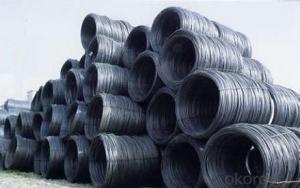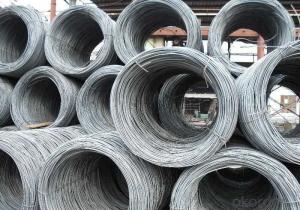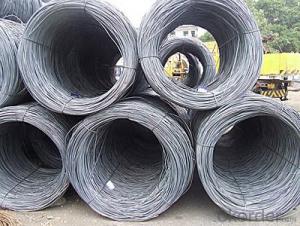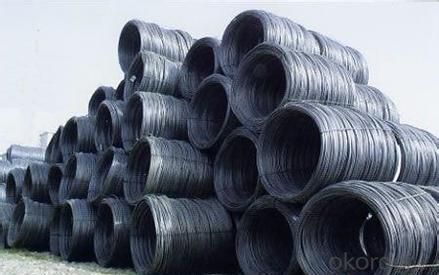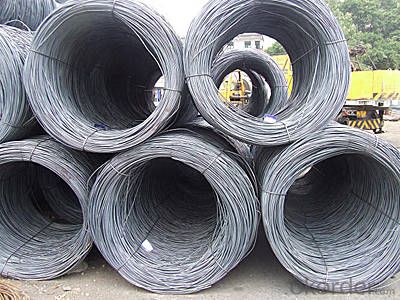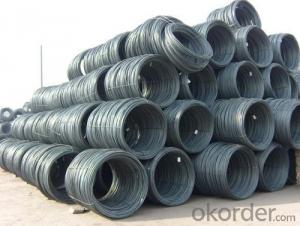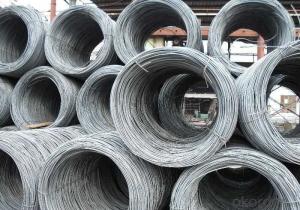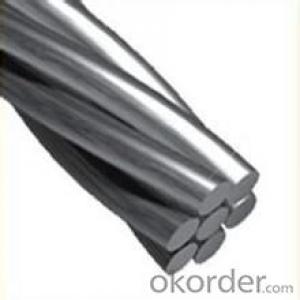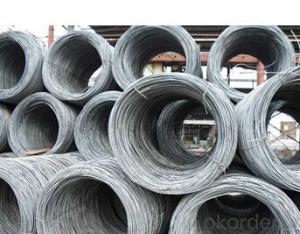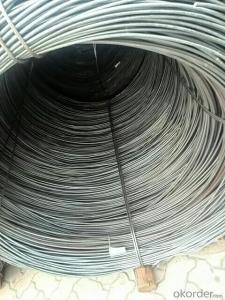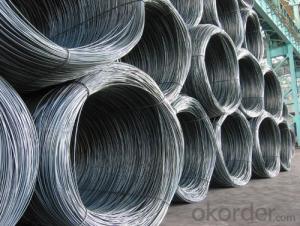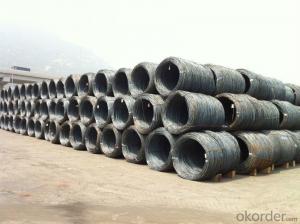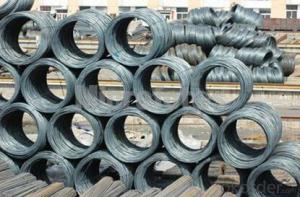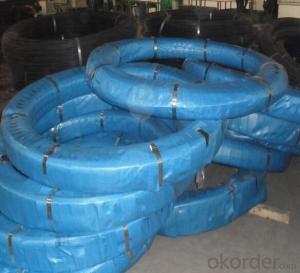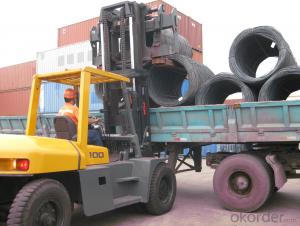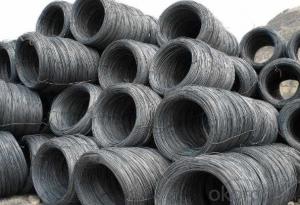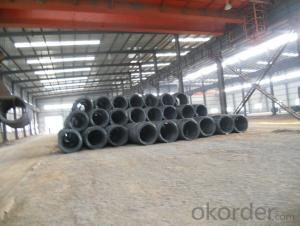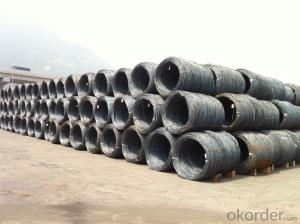Hot Rolled Carbon Steel Wire Rod 10mm with High Quality
- Loading Port:
- China Main Port
- Payment Terms:
- TT or LC
- Min Order Qty:
- 20 m.t.
- Supply Capability:
- 20000 m.t./month
OKorder Service Pledge
OKorder Financial Service
You Might Also Like
Product Description:
OKorder is offering Hot Rolled Carbon Steel Wire Rod 10mm with High Quality at great prices with worldwide shipping. Our supplier is a world-class manufacturer of steel, with our products utilized the world over. OKorder annually supplies products to European, North American and Asian markets. We provide quotations within 24 hours of receiving an inquiry and guarantee competitive prices.
Product Applications:
Hot Rolled Carbon Steel Wire Rod 10mm with High Quality is widely used in construction and manufacturing. Carbon steel wire rod is mainly used for reinforcement of reinforced concrete and welded structure or reprocessed (roberts , nail, etc.) materials, especially used to produce wire drawing, welding electrode, nails, spring, electronic, precise machinery parts and so on.
Product Advantages:
OKorder's Hot Rolled Carbon Steel Wire Rod 10mm with High Quality are durable, strong.packed and suitable for wire mesh,nail manufacture and construction
Main Product Features:
· Premium quality
· Prompt delivery & seaworthy packing (30 days after receiving deposit)
· Can be recycled and reused
· Mill test certification
· Professional Service
· Competitive pricing
Product Specifications:
Manufacture: Hot rolled
Grade: SAE1006 SAE1008 SAE1010 SAE1012 SAE1016 SAE1018
Certificates: ISO, SGS, BV, CIQ
Weight per Coil:2-2.05tons
Packaging: Export packing, packed by coil
FAQ:
Q1: Why buy Materials & Equipment from OKorder.com?
A1: All products offered byOKorder.com are carefully selected from China's most reliable manufacturing enterprises. Through its ISO certifications, OKorder.com adheres to the highest standards and a commitment to supply chain safety and customer satisfaction.
Q2: How do we guarantee the quality of our products?
A2: We have established an advanced quality management system which conducts strict quality tests at every step, from raw materials to the final product. At the same time, we provide extensive follow-up service assurances as required.
Q3: How soon can we receive the product after purchase?
A3: Within three days of placing an order, we will begin production. The specific shipping date is dependent upon international and government factors, but is typically 7 to 10 workdays.
Q4: How many tons can be loaded into one 20ft container?
A4: Around 18—20tons
Images:
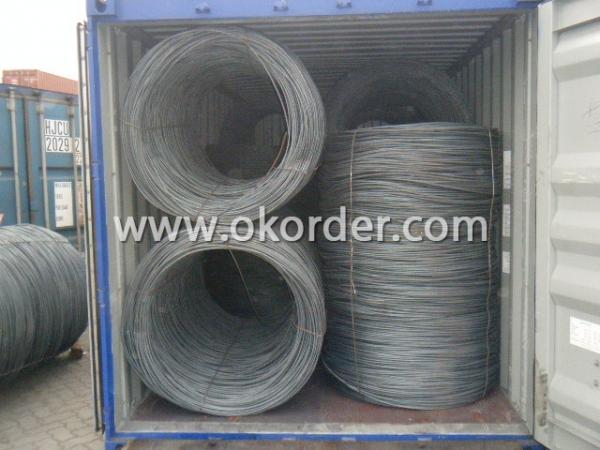
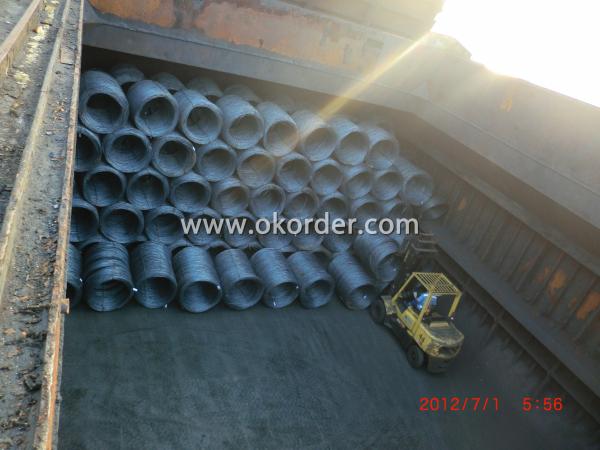
- Q: How is steel wire rod different from other types of steel products?
- Steel wire rod is different from other types of steel products because it is a semi-finished product that is primarily used for further processing into various steel wire and steel wire products. Unlike other steel products, such as bars or sheets, steel wire rod is typically hot-rolled and has a round cross-section. Its specific composition and mechanical properties are tailored to meet the requirements of wire drawing, making it suitable for manufacturing a wide range of wire-based products, such as nails, wires, cables, springs, and reinforcement materials.
- Q: How is steel wire rod used in the manufacturing of wire for electrical applications?
- Steel wire rod is used in the manufacturing of wire for electrical applications as it serves as the raw material for producing electrical wires. The steel wire rod is processed through various stages, such as drawing, annealing, and coating, to transform it into a high-quality and reliable wire that can conduct electricity effectively. This wire is then utilized in the production of electrical cables, wiring harnesses, and other electrical components, enabling the transmission of electricity in a safe and efficient manner.
- Q: What are the different types of steel wire rod drawing processes?
- The manufacturing industry utilizes several distinct steel wire rod drawing processes to transform steel wire rods into different shapes and sizes for diverse applications. These processes aim to cater to specific industry needs. Some commonly employed steel wire rod drawing processes are: 1. Cold drawing: This process involves the passage of the steel wire rod through a series of dies to decrease its diameter and increase its length. It is carried out at room temperature, often with the wire coated in a lubricant to facilitate the drawing process. 2. Annealing: This process entails heating the steel wire rod to a specific temperature and gradually cooling it to alleviate internal stresses and enhance its ductility. Annealing is frequently performed after cold drawing to enhance the wire's mechanical properties. 3. Tempering: This process is employed to further enhance the wire's mechanical properties by subjecting it to a specific temperature and then rapidly cooling it. Tempering aids in augmenting the wire's strength and toughness. 4. Coating: Steel wire rods can undergo a coating process to boost their corrosion resistance or improve their appearance. Common coating methods include galvanizing, where a layer of zinc is applied to the wire's surface, and electroplating, where a thin layer of another metal is deposited onto the wire. 5. Stranding: This process involves amalgamating multiple steel wire rods into a single strand. The individual wires are twisted together to form a stronger and more flexible strand, which is often utilized in applications like ropes and cables. 6. Drawing with intermediate annealing: In this process, the steel wire rod is cold drawn multiple times, with intermediate annealing steps in between. This helps in further reducing the wire's diameter and enhancing its mechanical properties. In conclusion, these various steel wire rod drawing processes enable manufacturers to produce wires with diverse properties, sizes, and shapes to meet the specific requirements of different industries and applications.
- Q: What are the different types of steel wire rod coatings used for increased strength?
- There are several different types of steel wire rod coatings that are commonly used to increase strength. These coatings are applied to the surface of the wire rod to enhance its mechanical properties and improve its overall performance. One common type of coating used for increased strength is zinc coating. Zinc coating, also known as galvanizing, involves immersing the wire rod in a bath of molten zinc. This process forms a protective layer of zinc on the surface of the wire rod, which provides excellent corrosion resistance. The zinc coating also acts as a barrier, preventing the wire rod from coming into direct contact with corrosive substances, thus increasing its strength and durability. Another type of coating used for increased strength is polymer coating. Polymer coatings are applied to the wire rod through various methods such as extrusion or electrostatic spraying. These coatings form a protective layer that offers resistance to abrasion, impact, and corrosion. Polymer coatings can also improve the wire rod's flexibility and resistance to fatigue, thereby increasing its overall strength. Additionally, epoxy coatings are commonly used for increased strength. Epoxy coatings, which consist of a mixture of resin and hardener, are applied to the wire rod's surface through a process called electrostatic deposition. These coatings provide excellent adhesion and chemical resistance, making the wire rod stronger and more resistant to corrosion. Furthermore, ceramic coatings are used to increase the strength of steel wire rods. Ceramic coatings are typically applied through thermal spraying techniques, where a ceramic material is heated and propelled onto the wire rod's surface. These coatings offer exceptional hardness, wear resistance, and high-temperature resistance, making the wire rod more robust and suitable for demanding applications. In summary, the different types of steel wire rod coatings used for increased strength include zinc coating, polymer coating, epoxy coating, and ceramic coating. Each of these coatings provides distinct advantages in terms of corrosion resistance, flexibility, adhesion, and wear resistance, ultimately enhancing the strength and durability of the wire rod.
- Q: How is the ductility of steel wire rod measured?
- The ductility of steel wire rod is typically evaluated using a test referred to as the tensile test, or the tension test. This test involves subjecting a sample of the steel wire rod to gradually increasing tensile forces until it breaks. Throughout the test, the elongation or deformation of the sample is measured, providing an indication of its ductility. During the tensile test, the steel wire rod sample is clamped at both ends, and a force is steadily applied to one end. As the force is applied, the sample begins to stretch, and the amount of stretching is recorded. Typically, this elongation is measured as a percentage of the original length of the sample and is known as the percentage elongation. Moreover, the tensile test also determines the ultimate tensile strength of the steel wire rod. This represents the maximum stress that the sample can endure before fracturing. The ultimate tensile strength is a significant factor for assessing the overall mechanical properties of the steel wire rod. By conducting tensile tests on multiple samples of the steel wire rod, it becomes possible to determine the average ductility of the material. This information is of great importance in various industries that utilize steel wire rod, including construction, automotive, and manufacturing. It enables engineers and designers to comprehend how the material will behave under different loads and conditions.
- Q: What are the potential drawbacks of using steel wire rod?
- There are several potential drawbacks of using steel wire rod. Firstly, steel wire rod is susceptible to corrosion and rusting when exposed to moisture or certain environmental conditions. This can lead to degradation of the material over time, reducing its strength and structural integrity. Secondly, steel wire rod can be relatively heavy compared to other materials, which can be a disadvantage in certain applications where weight is a concern. This can make transportation and handling of steel wire rod more challenging and expensive. Additionally, steel wire rod may have limited flexibility compared to other materials. This can be a disadvantage in situations where the wire needs to be bent or shaped into complex forms or tight spaces. Furthermore, steel wire rod can be more expensive compared to alternative materials, which can impact the overall cost of a project. The cost of production, transportation, and installation of steel wire rod can be higher, making it a less economical choice in some cases. Lastly, steel wire rod may have limitations in terms of its electrical conductivity or magnetic properties, which can be a drawback in applications where these properties are critical. Overall, while steel wire rod offers numerous advantages such as high strength and durability, it is important to consider these potential drawbacks before choosing it for a specific application.
- Q: How is steel wire rod used in the manufacturing of wire for mattress springs?
- Steel wire rod is an essential component in the manufacturing of wire for mattress springs. It serves as the primary raw material that is processed and transformed into the final wire used in the production of mattress springs. To begin the manufacturing process, steel wire rod is first carefully selected based on its specific properties, such as tensile strength, flexibility, and durability. These properties are crucial to ensure the wire can withstand the pressure and weight exerted on it when used in mattress springs. Once the appropriate steel wire rod is chosen, it undergoes a series of manufacturing steps. The first step involves heating the steel wire rod to extremely high temperatures, making it more malleable and easier to work with. This process, known as annealing, also helps to eliminate any internal stresses within the wire rod, making it more resistant to fatigue and prolonging its lifespan. After annealing, the steel wire rod is then cold-drawn through a series of dies to reduce its diameter and increase its strength and flexibility. This process, called wire drawing, involves pulling the wire rod through progressively smaller holes until it reaches the desired diameter. Once the wire rod is drawn to the correct diameter, it is further processed to enhance its surface finish and remove any imperfections. This can be achieved through various methods such as cleaning, polishing, or coating the wire with a protective layer. The final step in the manufacturing process involves coiling the wire into springs. The wire is fed into a specialized machine that coils it around a mandrel, forming the individual springs used in mattresses. The diameter and number of turns in the coil can be adjusted to meet specific requirements for different types of mattresses. In summary, steel wire rod plays a crucial role in the manufacturing of wire for mattress springs. It is transformed through processes such as annealing and wire drawing to enhance its strength, flexibility, and durability. The final wire is then coiled into springs, which provide the necessary support and comfort for mattresses.
- Q: How is steel wire rod used in the manufacturing of wire rope swivels?
- Steel wire rod is used in the manufacturing of wire rope swivels as the primary material for creating the rope itself. The wire rod is carefully twisted and braided to form the wire rope, which provides the strength, durability, and flexibility required for the swivel to function effectively.
- Q: What are the common applications of cold heading quality and oil tempered steel wire rod?
- The common applications of cold heading quality steel wire rod include the manufacturing of fasteners such as bolts, screws, and rivets. It is also used in the production of automotive parts, machinery components, and construction materials. Oil tempered steel wire rod, on the other hand, finds its common applications in springs, suspension systems, and other high-strength and high-performance applications where resistance to fatigue and durability are important factors.
- Q: How is steel wire rod tested for uniformity of coating?
- Steel wire rod is tested for uniformity of coating by conducting various physical and chemical tests. These tests include visual inspection, measurement of coating thickness using specialized instruments, adhesion tests, and corrosion resistance evaluation. Additionally, advanced techniques such as scanning electron microscopy (SEM) may be employed to analyze the coating's microstructure and ensure uniformity. These tests help to ensure that the steel wire rod meets the required standards and exhibits consistent coating quality throughout its length.
Send your message to us
Hot Rolled Carbon Steel Wire Rod 10mm with High Quality
- Loading Port:
- China Main Port
- Payment Terms:
- TT or LC
- Min Order Qty:
- 20 m.t.
- Supply Capability:
- 20000 m.t./month
OKorder Service Pledge
OKorder Financial Service
Similar products
Hot products
Hot Searches
Related keywords
